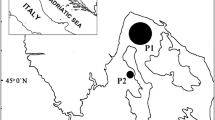Abstract
In order to evaluate the exposure risk of lead and cadmium in seafood for coastal residents in the coastline of the South China, representative seafood such as sea fish, crustaceans and molluscs were collected and used as research samples in many sampling points. By determining lead and cadmium content in sample using graphite furnace atomic absorption spectrometry, we carried out a safety evaluation of lead and cadmium contamination of seafood by single factor pollution index method. By calculating lead, cadmium intake of the coastal residents eating seafood, their exposure risk of lead, cadmium was assessed. It was found that, firstly, the content of lead and cadmium in mollusks was both higher than sea fish and crustaceans in the same waters. Secondly, the lead and cadmium pollution in seafood near the mouth of Pearl River was the most serious. Thirdly, lead and cadmium intakes of the coastal population eating seafood were at a basic level of security, but there were certain risks on the males less than 17 years old eating molluscs in Shenzhen Bay.



Similar content being viewed by others
References
Administration of Ocean and Fishers of Guangdong Province (GDAOF) (2013) 2013 Guangdong Provincial Oceanic Environment Quality Bulletin, pp. 2–12
Agusa T, Kunito T, Sudaryanto A et al (2007) Exposure assessment for trace elements from consumption of marine fish in Southeast Asia. Environ Pollut 145:766–777
Aylward LL, Becker RA, Kirman CR, Hays SM (2011) Assessment of margin of exposure based on biomarkers in bloods: an exploratory analysis. Regul Toxicol Pharm 61(1):44–52
Bai JH, Huang LB, Yan DH, Wang QG, Gao HF, Xiao R, Huang C (2011) Contamination characteristics of heavy metals in wetland soils along a tidal ditch of the Yellow River Estuary, China. Stoch Environ Res Risk 25:671–676
Chen LQ, Yu Q, Yang XL (1994) Global study on aerosol chemistry marine atmospheric III: metal speciation and flux. J Atmos 18(2):215–223
Cui Y, Chen BJ, Song YL et al (1997) Study on the content of heavy metals in marine organisms. J Appl Ecol 8(6):650–654
George SQ, Pirie BJS (1980) Metabolism of zinc in the musse1 Mytilus edulis (L): a combined ultrastructural and biochemical study. J Mar Biol Assoc UK 60:575–590
Hartwig A, Schwerdtle T (2002) Interactions by carcinogenic metal compounds with DNA repair processes: toxicological implications. Toxicol Lett 127:47–54
JECFA (1999) WHO technical report series 884. Evaluation of certain food additives and contaminants. Forty-ninth report of the Joint FAO/WHO Expert Committee on Food Additives. WHO, Geneva
JECFA (2010a) Summary and conclusions of the seventy-third meeting of joint FAO/WHO expert committee on food additives. FAO/WHO, Geneva, pp 1–17
JECFA (2010b) Food additives summary and conclusion. JECFA/73/SC, Geneva
Jin Y, Liu P, Sun J et al (2014) Dietary exposure and risk assessment to lead of the population of Jiangsu province, China. Food Addit Contam Part A 31(7):1187–1195
Lachenmeier DW, Przybylski MC, Rehm J (2012) Comparative risk assessment of carcinogens in alcoholic beverages using the margin of exposure approach. Int J Cancer 131(6):995–1003
Li Q, Song JP, Wang ER, Hu H, Zhang JH, Wang YY (2014) Economic growth and pollutant emissions in China: a spatial econometric analysis[J]. Stoch Environ Res Risk 28(2):429–442
Liu Y, Zhou MY (1999) Time and geographical distribution of aerosol in marine atmosphere China. Acta Oceanol Sin 21(1):32–40
Ministry of Commerce of the People’s Republic of China (MOF) (2005) Commerce Department export Technical Guide—food contaminants, pesticide limits
National Coastal Zone Office (1989) China comprehensive survey of coastal zone and tidal wetland resources professionals report set a survey of environmental quality. Ocean Press, Beijing
National Health and Family Planning Commission of the People’s Republic of China (NHFPC) (2013) GB 2762-2012
Phillips DJH (1979) The rock oyster Saccostrea glomerata as an indicator of trace metals in Hong Kong. Mar Biol 53:353–360
Phillips DJH (1985) Organochlorines and trace metals in green-lipped mussels Perna virid from Hong Kong waters: a test of indicator ability. Mar Ecol Prog Ser 21:251–258
Reffstrup TK, Larsen JC, Meyer O (2010) Risk assessment of mixtures of pesticides. Current approaches and future strategies[J]. Regul Toxicol Pharm 56(2):174–192
Shuai JS, Wang L (2001) Discussion on the influence of heavy metal pollution on human health and Countermeasures. Environ Dev 16(4):62–66
State Oceanic Administration People’s Repiblic Of China (SOA) (2002) GB 18668-2002
Tang HL, Guo Y, Meng XZ et al (2008) Research of coastal cities in Guangdong province residents dietary structure and food pollution—for persistent halogenated hydrocarbons and heavy metals assessment of human exposure. J Agro Environ Sci 28(2):329–336
The Chinese Nutrition Society (2000) Chinese dietary reference intakes. China Light Industry Press, Beijing, pp 14–15
Tian L, Lu XT, Gao A (2008) Application of benchmark dose for occupational epidemiology in lead exposure. Toxicol Mech Method 18(4):363–367
Vicente-Martorell JJ, María D (2009) Bioavailability of heavy metals monitoring water, sediments and fish species from a polluted estuary. J Hazard Mater 162:823–836
Wiwanitkit V, Suwansaksri J, Soogarun S (2008) High blood lead level among the Mahayana Buddhist monk: a note for environmental implication. Stoch Environ Res Risk 22:805–807
Yang ML, Lin YT (1990) The analysis and evaluation of heavy metals in marine organisms of Dayawan. Mar Environ Sci 9(3):41–47
Ziegler EE, Edwards BB, Jensen RL et al (1978) Absorption and retention of lead by infants. Pediatr Res 12:29–34
Author information
Authors and Affiliations
Corresponding author
Rights and permissions
About this article
Cite this article
Hu, S., Su, Z., Jiang, J. et al. Lead, cadmium pollution of seafood and human health risk assessment in the coastline of the southern China. Stoch Environ Res Risk Assess 30, 1379–1386 (2016). https://doi.org/10.1007/s00477-015-1139-9
Published:
Issue Date:
DOI: https://doi.org/10.1007/s00477-015-1139-9




